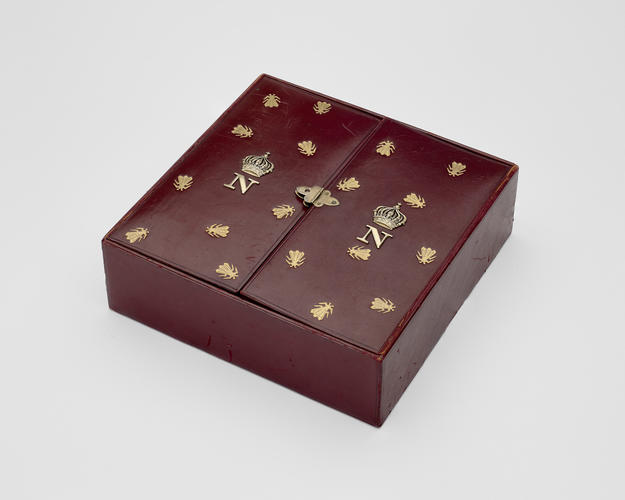Travelling desk set c. 1770
Silver gilt, in tooled and gilt leather box with red velvet lining | 1749.2 g (Weight) (whole object) | RCIN 48388
-
A rectangular leather travelling box tooled with a gilt decoration of bees and applied with crowned N monograms. Contains a pair of urn-shaped gilt metal inkwells with detachable covers cast with foliage and flowers, a similar sandwell, a candlestick and a table bell with a handle of vine leaves.
Silver gilt elements unmarked; plaque engraved, The Emperor Napoleon's Inkstand / TAKEN FROM HIS CARRIAGE ON THE FIELD OF WATERLOO; inner tray inscribed on base, in ink, Joseph.Provenance
Said to have belonged to Emperor Napoleon I and to have been taken from his carriage at Waterloo by Captain Horace Beauchamp Seymour. Given to Hon. Marmaduke Langley, son of the 4th Viscount Downe, then by descent through the Dawnay family; presented to Queen Victoria by Mary Isabel, Viscountess Downe in 1897 on the occasion of the Diamond Jubilee. The leather case with its carefully stamped gilt bees and N monograms is a later addition to the set, probably created when the object was presented to Queen Victoria.
Despite the plaque attached to the case of this travelling writing desk, insisting it came from Napoleon's carriage at Waterloo, it is unlikely that this case was ever in Napoleon's personal carriage. Bonaparte's 'dormeuse' or campaign carriage was admirably fitted out with all the necessities of military life – including a travelling bed, dining, dressing and surveying equipment as well as a writing desk. He was also well supplied with necessaires de voyage by Martin-Guillaume Biennais, many of which contained implements for writing. Moreover, it was the Prussian army, thought to be fresher after their later arrival at the field of Waterloo, who were sent in pursuit of the fleeing French baggage train, and it was a Prussian officer, Major Eugen von Keller, who took Napoleon's carriage. Furthermore the writing equipment bears none of the usual additions of Napoleonic ciphers or his personal emblem of bees which might be expected on the Emperor's own ecritoire.
Captain Horace Beauchamp Seymour was however one of the heroes of Waterloo. An officer in the 18th Hussars, Seymour served as the aide-de-camp to Lt. General Henry William Paget, Earl of Uxbridge, commander of the British cavalry on the battlefield. Seymour was recorded as being the 'strongest man in the British army' and is thought to have killed more men during the battle than any other individual. He narrowly escaped capture by the French general, Marshal Ney. It may certainly be therefore that he was able to snare the inkstand from one of the French officers, or possibly from the inn of the Belle Alliance where the French had set up their command post, and which became the rendez-vous point for the allied forces on their victory. Seymour went on to become an MP and a Gentleman Usher to the Prince Regent and later equerry to William IV and Queen Victoria and an Extra-Equerry to Queen Adelaide. -
Creator(s)
(nationality)Acquirer(s)
-
Medium and techniques
Silver gilt, in tooled and gilt leather box with red velvet lining
Measurements
1749.2 g (Weight) (whole object)
Place of Production
France












